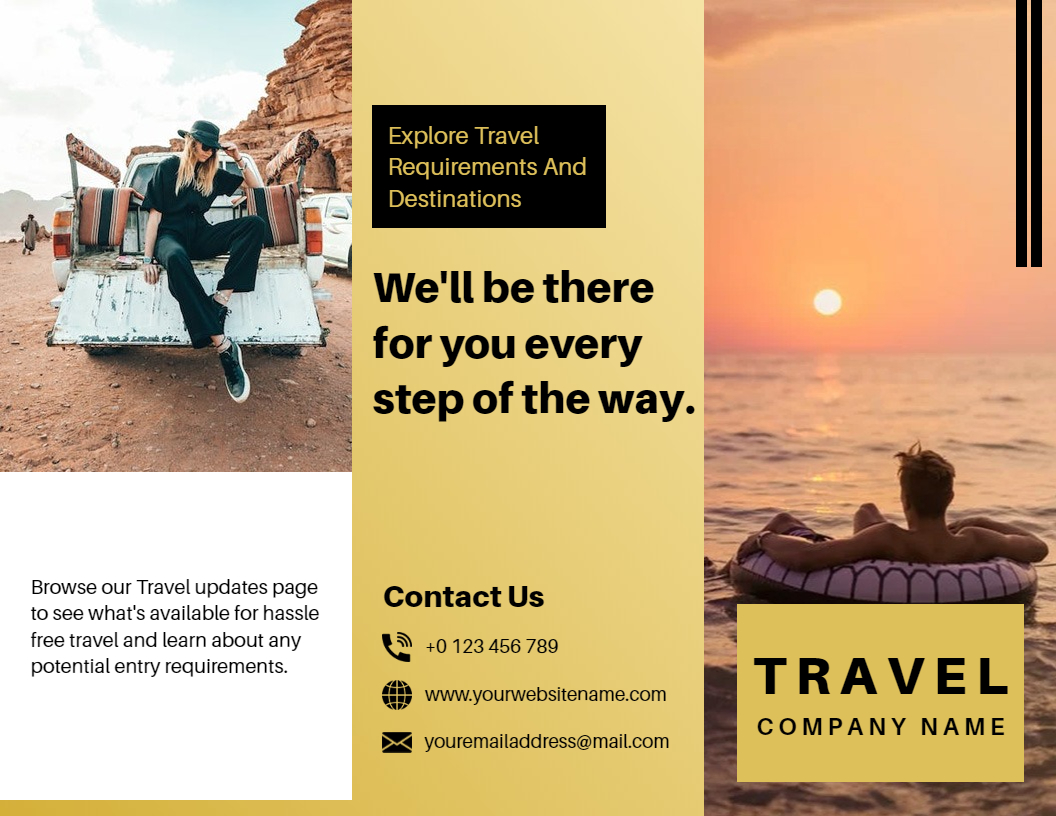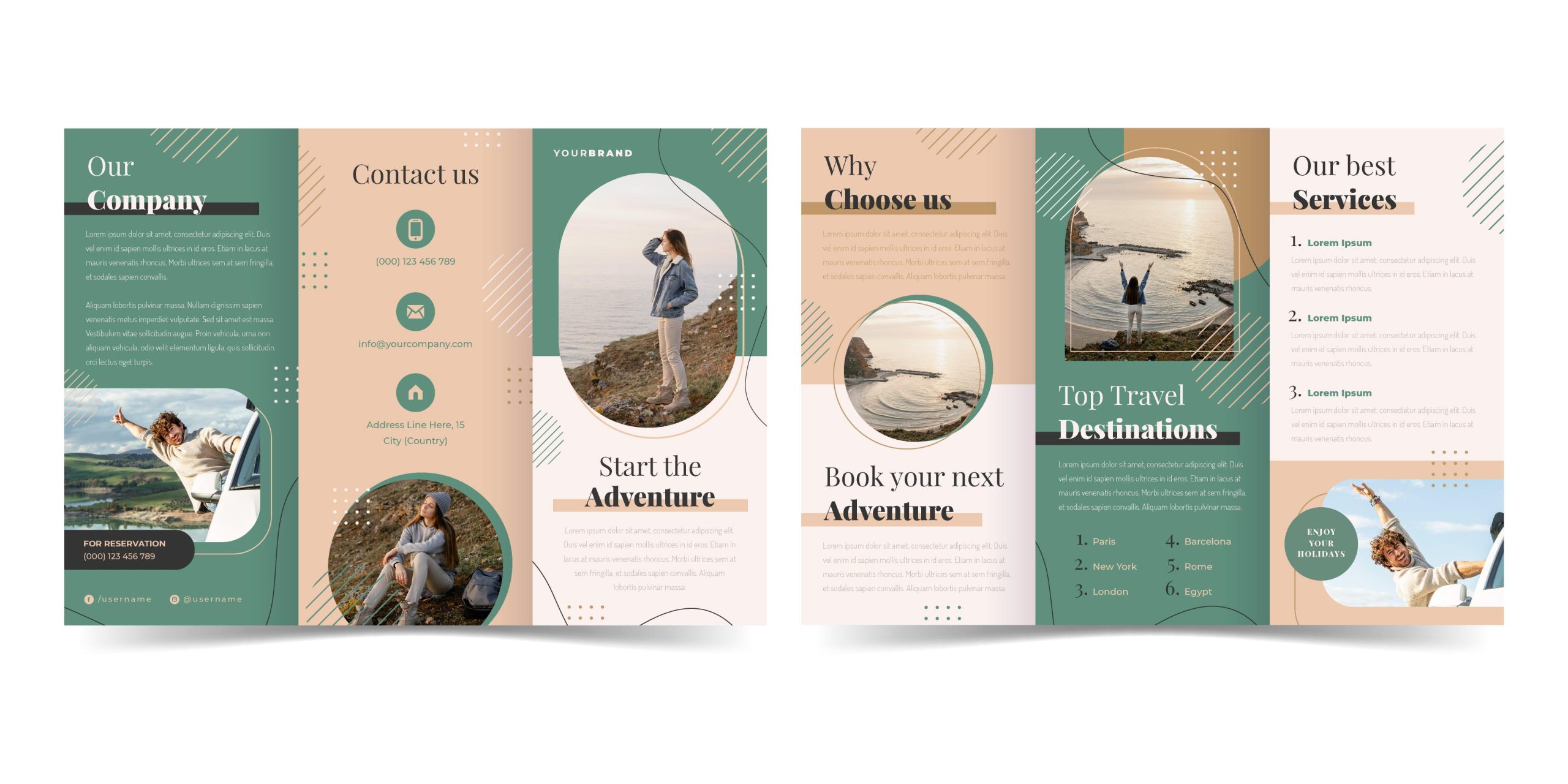Travel brochures aren’t just for five-star resorts; nearly any business, from museums to mom-and-pop shops, can be a travel destination. If your business can consider a tourist attraction, we’ll show you how to create a travel brochure.
The finished product can print and distributed almost anywhere: a local rest stop, restaurant, travel agency, state park, or city tourism office. You can also share your brochure online to spread the word for free.
We’ll walk you through each step so you can finish your brochure quickly.
But Wait,
If you’re short on time or don’t have much design experience, brochure templates can save you a lot of time and provide you with a very professional-looking travel brochure. Using PhotoAdKing, you can select a template that corresponds to your destination and then customize it to your liking and you can make many types of travel brochures like TriFold, BiFold, 3D Trifold, etc.


Use the right photo to entice readers
The photos in your travel brochure are most likely the most important part. The photos will entice the reader and help them imagine themselves in the travel destination. You don’t want to cut corners here; if the photos look cheap, the destination will appear cheap. It’s also critical to know what to highlight.
Consider what will appeal to your customers and the type of vacation they desire. Depending on your target audience, you could, for example, show the luxurious interior of a mountain resort or a group of people around a campfire in the woods.
I discovered a few photos on Unsplash that are excellent examples of the types of images you’ll want in your travel brochure: they’re sharp and beautiful, and they make you want to walk right into them. Take a look at this:
Include a few photos of people having a good time so that customers can imagine themselves at your destination. If you run a horseback riding service, for example, you’ll want photos that highlight the natural wonders of your tours. However, you should also include images of families having fun on a ride.
The quality of your photographs will determine whether your brochure succeeds or fails, so choose photos that look great while accurately representing your location. Consider hiring a professional photographer to capture the charm of your destination if it is unusual or unique. You’ll undoubtedly attract visitors looking for something off the beaten path.
Use a color scheme
The colors of your travel brochure have a significant impact on how it can receive. Because the color scheme will most likely be the first thing that people notice about the brochure, it will be beneficial to be familiar with the psychological effects that colors have on us. You want your brochure to have the same feel as the destination you’re promoting.
Blue, for example, can convey calm, peace, and trust, and lighter blues are especially soothing. Light blues will probably send the right message if your destination is relaxing and your target customer is looking for a peaceful vacation.
Consider how the colors you choose will blend with the photos in your brochure (more on photos later). To achieve a unified feeling, the color scheme and photographs should complement each other. Assume you want to position your beach destination as both playful and calm. You could use the following color scheme:
The colors in your brochure and photos could complement each other within this color scheme to help customers understand what to expect. If, on the other hand, your destination can rugged and adventurous, you could try this:
By adding a little tint, the same color scheme can transform. I found complementary colors and customized them using an online color wheel tool. Also, if you’re looking for a more in-depth guide to choosing the right colors, check out this helpful post from Quicksprout.
Once you’ve decided on your photos and color scheme, your brochure will begin to take shape. There’s one
A more important consideration: is what your brochure will say.
Write descriptive copy
Write captivating copy that describes the images to further engage your readers. Simply keep your text friendly, genuine, and upbeat. However, keep it brief and concise so that your readers can quickly grasp the main points: include plenty of subtitles, bullet points, and other design elements for tourists who prefer to scan the text. Here are some ideas for what to include in your copy:
Include reviews: Nowadays, tourists prefer to read reviews from other travelers before planning a trip rather than official booklets, and they are much more likely to trust content created by their peers. So you can collect customer feedback and ask for permission to post it online. This will help you build trust and, as a result, increase bookings.
Highlight your advantages: When deciding where to go, travelers look through numerous travel brochures and booklets, and market competition is fierce. To differentiate yourself from the crowd, list your benefits in a compelling and concise manner: pricing and discounts, unique locations, exclusive entertainment, and so on. Show your readers why they should choose you over others.
Share local tips: Including local tips in a travel brochure is a great way to make it more engaging. This type of knowledge is difficult to come by, making it even more valuable. Speak with locals about their favorite cafés and shops, or a must-see picnic spot. You can also share travel hacks such as where to find cheap trains, flights, and cabs. Your readers will appreciate the fact that your information is unique.
Include Geographical Details and Contact Info
Put your attraction’s address and contact information right on the cover. Inside the brochure, don’t forget to include detailed explanations and directions to your location. Make it simple for your readers to contact you by phone, email, or by visiting your website.
Maps are another essential component of any travel brochure. Place a general map near the front of your brochure as a reference point, and then include more specific maps in the following sections to provide the necessary local information.
Conclusions:
We will cover how to create stunning travel brochures that will help you increase your business’s reach and conversion, as well as share useful brochure templates tool that will help you save time and customize professional travel templates.

